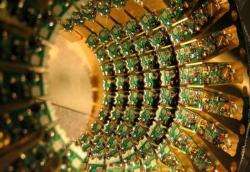December 15, 2009 weblog
Google Collaborates with D-Wave on Possible Quantum Image Search

(PhysOrg.com) -- Always on the cutting edge of new computing technologies, Google has recently announced that it is investigating the use of quantum computing schemes to achieve faster image recognition rates. Last week, at the Neural Information Processing Systems conference (NIPS 2009) in Vancouver, Canada, the company demonstrated that their new search technology outperforms the algorithms used on the computers running in its data centers today.
For the past three years, Google researchers have been investigating how quantum algorithms might provide a faster way to recognize a specific object in an image compared with classical algorithms. In their recent demonstration, the researchers used quantum adiabatic algorithms discovered by Edward Farhi and collaborators at MIT.
To find hardware for implementing these algorithms, Google approached the technology company D-Wave, based in Vancouver, Canada. As Hartmut Neven, Google's Technical Lead Manager in Image Recognition, wrote on Google's research blog, the algorithm is run on a D-Wave C4 Chimera chip.
"D-Wave develops processors that realize the adiabatic quantum algorithm by magnetically coupling superconducting loops called rf-squid flux qubits," wrote Neven. "This design realizes what is known as the Ising model which represents the simplest model for an interacting many-body system and it can be manufactured using proven chip fabrication methods."
At the NIPS 2009 conference, Google demonstrated how its algorithm could recognize cars in images. First, the researchers trained the system by showing it 20,000 photographs, half of which contained cars that had boxes drawn around them, while the other half had no cars. After the training, the researchers presented the algorithm with 20,000 new photos, with half containing cars. The algorithm could recognize which images had cars significantly faster than the algorithms used by any of Google's conventional computers.
While the quantum adiabatic algorithm has improved image recognition performance, many outside experts question whether D-Wave's adiabatic quantum computer is truly quantum. Over the past few years, D-Wave has had a history of making exaggerated claims about its technology with a lack of solid evidence, evoking a lot of skepticism and hurting its credibility. On his blog, Scott Aaronson, a computer scientist at MIT, has recounted the scientific audience's response to a recent D-Wave presentation. Even Neven admits that Google doesn't claim that their new technology satisfies quantum requirements.
"Unfortunately, it is not easy to demonstrate that a multi-qubit system such as the D-Wave chip indeed exhibits the desired quantum behavior and experimental physicists from various institutions are still in the process of characterizing the chip," Neven wrote.
More information: A theory paper and demo paper on Google's technology
© 2009 PhysOrg.com
















